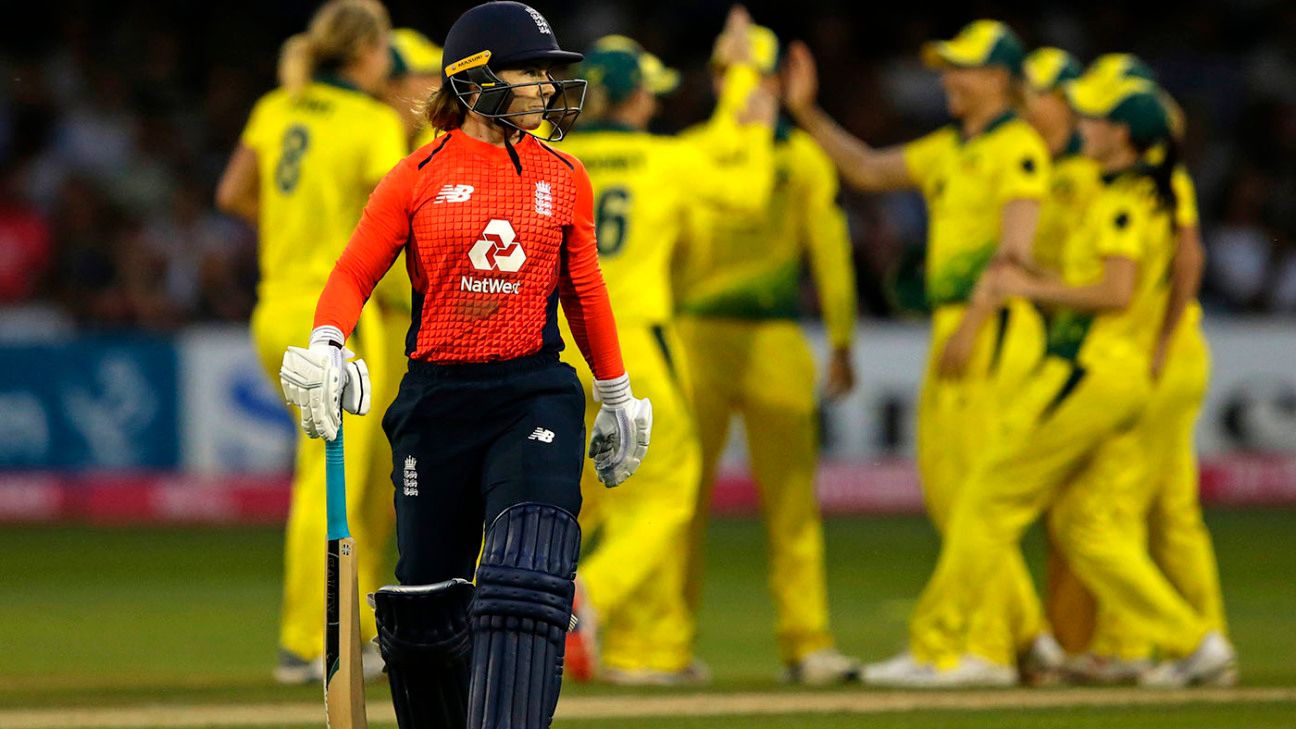
Stop all the clocks, cut off the telephone, Prevent the dog from barking with a juicy bone. Silence the pianos, and with muffled drum, Bring out the coffin, let the mourners come.
The inquest into England women's thrashing by Australia is in full swing, and the tone is predictably funereal. It would hardly be an Ashes drubbing without much weeping and gnashing of teeth by the defeated side, and this series has proved no different.
The facts are there for all to see. Australia retained the Ashes at the earliest possible opportunity; they lead 12-2 overall with one game to play, and England are only on the board thanks to the quirk of the points system giving the teams two each, rather than none, for a drawn Test.
Across the formats, Australia have four of the five leading run-scorers, and four of the leading six wicket-takers. Ellyse Perry has dismissed Amy Jones four times in the 25 balls she has bowled at her; Anya Shrubsole, the star of the 2017 World Cup final, has taken five wickets at 50.60. No matter where you look, the picture is bleak.
But perhaps the most surprising thing about this defeat is that it has come as a surprise at all.
Yes, England had won 14 white-ball games on the bounce, a record not to be sniffed at. But consider this: since 2018, Australia have lost two games in all formats - one of which was against India in a dead rubber at the World T20 - and won 29. They have five times the number of professional cricketers that England do. In Perry and Meg Lanning, they possess two of the game's modern greats.
Of course, losing five white-ball games on the spin is nobody's idea of fun - this is England's worst run since 2007 - and the manner of the defeats at Grace Road and Chelmsford bordered on embarrassing.
But heavy defeats do not spring about simply through a lack of application or talent: the simple truth is that England's domestic structure is miles behind Australia's.
Before its first season in 2016, the Kia Super League was sold as a silver bullet, but has hardly produced many stars. The only two English players in last season's top ten run-scorers were Heather Knight and Nat Sciver, both established internationals already; the best domestic bowlers were Sophie Ecclestone, who has been around the national squad for several years, and Kirstie Gordon, whose struggles in the Test at Taunton were there for all to see.
Meanwhile, the noise around a mooted domestic restructure has been a source of confusion. Plans to remove funding for county cricket were greeted with predictable dissatisfaction, and after a consultation process, the ECB will now run and fund a county T20 competition in 2020 and 2021.
The headline, though, is that around ten regional teams will play 50 and 20-over cricket from next year, in a bid to give 100 or so players the opportunity to make a living from the game, while contracts for The Hundred are expected to be substantial more lucrative than what is currently on offer in the KSL.
For now, there is no easy fix. The 21 players currently holding central contracts will continue to form the basis of the side for a few years yet, and England will continue to be dominant against most teams, and struggle against Australia.
"We're investing £20 million in the next two years into transforming the game for women and girls," Claire Connor, the managing director of women's cricket at the ECB, told Sky after the second T20I at Hove. "We've got six priorities within the new strategy, and transforming the game for women and girls is one of those six.
"We had a very important board meeting last week at which the full two-year plan as to how that £20 million of investment will all break down. That was all approved by the board last week so whilst this [Ashes series] was disappointing and there are huge lessons for us all to learn, we must be very optimistic about the opportunity that lies ahead for us.
"[Australia's] system over the last four or five years has put them in a really good position for this Ashes series, and whilst we've had the Kia Super League over the last four years, which has undoubtedly helped bridge the gap between our domestic game and the international game, there is a huge amount more we need to do.
"Australia have capitalised on the investment and the plan that they've made over the last four or five years and they've played some outstanding cricket this summer."
Tammy Beaumont, one of the few England players to come out of this series with her reputation enhanced, is of the same view. "You see how Australia have gone about their things," she said. "The number of players that are coming into their squad - they're 20-year-old superstars.
"But it will take time, it's not a quick fix by any means. At the moment we've got a lot of belief in the group we've got, we've got to change a few things and work really hard and come back stronger, but looking to the future in maybe four years, five years' time, that's what's got to happen."
In the immediate term, the focus is on February's T20 World Cup in Australia. An international system with such clear disparities between sides means that England can already be confident of reaching the semi-finals. With Australia, India, and New Zealand all drawn in the other group, England's pool looks much the easier of the two, and a semi-final exit could hardly be considered an awful return.
Until that point, the ECB will be keen to ensure that as many of the squad as possible plays in the WBBL this winter, before moving into a tri-series with Australia and India at the start of 2020.
And the immediate focus is on winning Wednesday night's game at Bristol: it is a dead rubber in theory, but in practice, England are desperate to register a consolation victory. If they do, the dreary mood about the side might finally start to lift.















 Phone: (800) 737. 6040
Phone: (800) 737. 6040 Fax: (800) 825 5558
Fax: (800) 825 5558 Website:
Website:  Email:
Email: 






